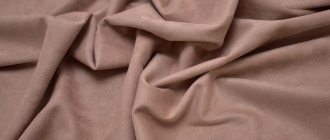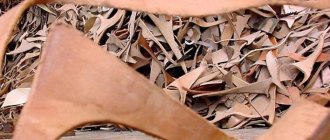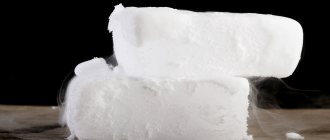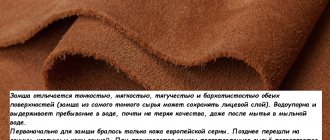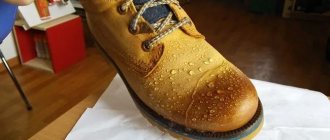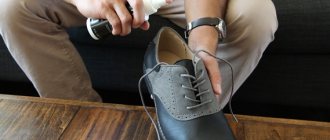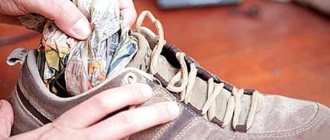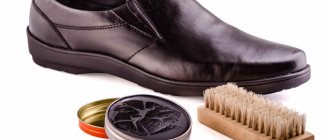Things and accessories made of suede have enjoyed constant success not only among women, but also among men for many decades. This is a fairly expensive type of leather, but, as sad practice shows, today it is difficult to judge the quality of the product even by price.
Modern textile and chemical industries have reached such a level of development that it is not difficult to create artificial materials, passing them off as natural. Unscrupulous sellers take advantage of this by offering customers shoes and other products made from artificial suede, brazenly passing it off as natural. Some consumers simply do not know how to distinguish a fake from the original for a simple reason: they do not know how suede is produced, how it differs from other fabrics and what it looks like.
What is suede
Suede is a material produced by tanning the skins of small animals. Suede has no face, soft, thin and velvety on both sides. Due to the unique characteristics of strength and at the same time elasticity, suede is used to make clothes, shoes and other products.
An interesting fact is that initially suede was thick, as it was created from the skins of cattle, and only over time it began to be made from the skins of small livestock.
Where is it used?
Suede leather is used in the textile industry and for clothing. Women's and men's jackets, jackets, coats, blazers, vests, and sheepskin coats are made from suede. In addition to outerwear, suede gloves, hats, berets, and scarves are produced. Things made of warm soft material are worn in autumn and winter.
Fleecy fabric is suitable for sewing both winter boots and summer sandals or demi-season boots, shoes, ugg boots, ankle boots, sneakers, loafers, sneakers.
Read also: How to remove a contact from your Google account?
Suede is used to make and decorate bags, cases, business card holders, and wallets. You can often find suede belts, bracelets, chokers with metal or other decor. Covers for sofas, armchairs, and car seats are made from this material. It is impregnated with special compounds that increase resistance to abrasion and damage.
In addition to sewing, suede is used in technical production for grinding lenses, cleaning optical surfaces, and making fuel filters. In addition, the material is suitable for the manufacture of orthopedic medical equipment.
The history of suede
Animal skins began to be used in the production of materials back in the 9th century. Then it was treated with various fat-containing products to improve its performance properties. After about nine centuries, fish oil and various plant mixtures began to be used to soften the skin. The technology gained popularity and reached Russia. Here, suede gained particular popularity in Nizhny Novgorod and Arkhangelsk, where tanners were called ireshniks (from the word “irha” - suede), and the process itself was “fleshed” or “vezhit”. Suede began to be produced on a commercial scale only in the 19th century.
Production technology
The process of sueding natural leather using tanning substances helps give suede strength, ductility, softness and velvety. The production of suede fabrics is divided into several stages:
- Preparing skins with pre-haired skins.
- Skinning is the removal of the dense top layer.
- Treating the hide with formaldehyde.
- Applying seal, cod, whale oil or a vegetable mixture to the cleaned skin.
- Placing the fabric in special impact grinders, where the fat is absorbed into the fibers.
- The skins are folded and heated.
- The fatliquoring procedure is repeated, if necessary, several times.
- Degreasing the canvas in a potash solution.
- If necessary, the material is treated with abrasive for greater hairiness.
- The canvas is painted. Since it is initially brown in color.
Features of the material
- Natural suede is made from the skin of animals: from goats and deer to calves and sheep. It is important to know that natural suede has a slight hairiness, unlike artificial materials and velor. To figure out whether the suede you have in front of you is natural or artificial, you should understand the production technology of the fabric: animal skin is impregnated with fats. In such products the skin breathes.
- Artificial suede is a fabric made from microfiber threads. If the fabric is made using a non-woven method, then a polymer composition is applied to the fabric, which is then processed using a laser.
Properties of natural suede
Due to its natural origin, suede is considered a hypoallergenic and wear-resistant material. High-quality suede products last a long time, do not accumulate static electricity, allow air to pass through well and do not fade over time. The material is resistant to deformation and moisture.
What does the fabric look like?
Externally, the material looks elegant and noble. The soft and uniform velvety surface is pleasant to the touch. The fabric can be thin, which means it fits well and fits in beautiful neat folds, or thick, which means it can be denser and more shaped.
Does suede stretch or not?
Compared to genuine leather, suede is a more pliable and soft fabric. Thanks to its elastic properties, suede shoes break in well and fit perfectly on the foot. However, if the selected suede shoes or boots are short in length, tight, or do not fit well, it is not recommended to buy such products. If you experience only slight discomfort after buying new shoes, you can get rid of it at home using a special shoe stretcher.
Application and Use
Things made from natural material are convenient, soft, light, comfortable, do not allow moisture to pass through, look elegant, and speak of the good taste of their owner. Suede is used for sewing outerwear, shoes, and accessories. Designers, fashionistas, and stylish men adore her. Areas of application:
- When sewing clothes. Used for outerwear: sheepskin coats, coats, jackets, trench coats.
- Shoes and accessories. The price of suede is higher compared to other materials; shoes, jewelry, bags, gloves, and straps made from expensive fabric are considered luxury.
- Furniture upholstery. For this purpose, artificial canvas is often used as it is more unpretentious, practical, and will not become deformed.
- In optics. Used for grinding lenses and optical surfaces.
- It is widely used in orthopedics due to its antiallergic properties, special softness, and moisture resistance.
When sewing clothes
Clothes are made from natural and artificial fabric. Sewing features:
Natural suede is used to make outerwear (jackets, raincoats, sheepskin coats, coats). Artificial, obtained by woven method, is used for sewing outer demi-season and winter clothing (raincoats, jackets), trousers, dresses, shirts, skirts, blouses. For cutting, ordinary scissors are used, the needles are sharp, as for sewing jeans.
Puncture holes may be visible when cutting, so cutting must be done carefully. Additionally, it is not necessary to bend or process the edges with an overlocker; you can make the edge zigzag with special scissors
Loose styles of the product will help better penetration of air to the body.
Shoes and accessories
Suede shoes are always relevant, elegant, never go out of fashion, and can be combined with a variety of clothes. At the peak of popularity are suede stocking boots that will perfectly complement any look. Winter suede boots, due to their breathability, waterproofness, and lightness, are more practical than similar leather models. In such shoes, the foot does not sweat, keeping perfectly warm. Split leather is used to make shoes and accessories: thick, layered skins of large animals. This material is used in mass production and is cheaper than other types.
Upholstery
For furniture upholstery, it is more practical to use artificial suede obtained using a non-woven method. This material is cheaper and more unpretentious than its natural counterpart. Suede upholstery enhances furniture, is pleasant to the touch, is not subject to deformation or defects, is durable, does not fade over time, and is suitable for any interior style. It does not tolerate wet cleaning and is damaged by mechanical friction, but with the help of a vacuum cleaner and careful cleaning with a sponge and a special product it will last a very long time.
In optics
Natural, lint-free suede is suitable for practical use in the precision and optical industries. Perfectly absorbing moisture without leaving marks or scratches on the surface of the lens, it is used for wiping and polishing. In everyday life, a microfiber cloth is used that destroys microorganisms and household dirt. Capable of removing stains and fingerprints from plasma TVs, LCD monitors, and photo lenses.
In orthopedics
Suede orthopedic shoes, thanks to their modern design, natural breathable materials, variety of colors, are comfortable to wear and pleasing to the eye. For the production of insoles and orthopedic shoes, technical suede is used (GOST 3717-84). It is made using a fatty, formaldehyde-fat tanning method for tanning the skins of goats, milk, deer, and sheep. Such raw materials are yellowish-brown in color, with short pile.
Pros and cons of natural suede
Like any other material, suede has advantages and disadvantages.
Advantages of natural suede:
- Aesthetic appearance. Suede items look chic, but at the same time neat and noble.
- Long service life. If you properly care for the material, it will remain in its original form for a long time. Even abrasions and small defects will not spoil the quality of the canvas.
- Thermal insulation properties. The fabric retains heat well in winter and cool in summer, so it is indispensable in the production of clothing and footwear.
- Comfort. Suede clothes are very comfortable. The material does not restrict movement, is very pleasant to the body and allows the skin to breathe.
- Compliance. The elastic properties of suede help fabrics stretch and quickly restore their original shape.
- Antistatic and hypoallergenic. Due to its natural nature, suede does not accumulate static electricity and does not cause allergic reactions.
Despite the many advantages, the material also has disadvantages:
- Absorbs moisture. This affects the comfortable wearing of clothes and shoes and their aesthetic appearance, since the material, together with moisture, attracts dirt and takes a long time to dry.
- Instability to mechanical stress. The material is quite easy to tear.
- Difficulty of care. Suede items require delicate handling, dry cleaning and additional procedures to preserve their appearance.
- High price. Compared to artificial analogues, natural suede is more expensive.
Sometimes suede manufacturers coat their fabrics with special compounds to reduce the risk of damage.
Useful tips for choosing suede
Suede is a high-quality, but whimsical and expensive material. Therefore, you need to think a hundred times before purchasing something made from genuine leather. If you are purchasing suede for the first time, it is recommended to give preference to artificial material. It won't be such a shame if you can't properly care for the product.
There are some more useful tips for choosing suede:
- When purchasing a product, you need to pay attention to the lining . It must be movable, which will prevent deformation of the material.
- The natural product stretches well. Therefore, it is not recommended to buy things, especially shoes, clothes “to grow.”
- It is difficult to find suitable clothes for suede, so before buying you should think about whether there are suitable things in your wardrobe . Otherwise, expensive clothes will hang uselessly in the closet.
- The first “suede” purchase should be an accessory: handbag, gloves, strap, wallet. This will help you get used to the material and find out if it is right for you.
Attention! When purchasing, you need to pay attention to how the products are stored. There must be a special filler inside the shoe to prevent deformation. Clothes should hang on hangers.
If a person prefers to wear clothes made of suede, this speaks of his impeccable taste. Well-groomed, clean things bring joy to the owner for many years and allow him to stay warm in cold weather and increase his status in the eyes of those around him. What to choose, a natural product or synthetics, is a personal decision of each person, in which material capabilities play a large role.
Kinds
In the range of textile products you can find several types of natural suede. Each of them has its own characteristics and properties.
By thickness
There are 2 types of material:
- Refined grade - has excellent breathability. Made from goat or deer skins.
- Unrefined variety - the fabric is denser and less elastic. Made from sheep and calf skins.
Double face double sided
The name “double face” means that the fabric has two front sides. Typically, such suede material has a velvety front and a fur base on the back. Double front suede is usually used for sewing warm outerwear and non-rough shoes.
Scuba
Suede on a scuba is a material consisting of 2 layers: artificial suede and knitted fabric. The fabric is more durable than natural suede, stretches well, is less sensitive to external influences and costs less. The material is easy to care for and can be used for sewing clothes and shoes.
Coasting
Natural suede treated with laser coating. This treatment reduces the traumatic nature of the material and the possibility of surface abrasion. Products made from rolled suede look more impressive due to their characteristic shine.
Synthetic
Made from synthetic polyester or microfiber fibers. Externally, synthetic suede is practically no different from natural one, but has additional advantages in the form of resistance to dirt and deformation.
Reinforced
Special suede cleaning wipes eliminate the use of household chemicals. The fabric consists of polyester fibers. It has a velvety surface that helps clean surfaces without streaks and additional effort.
Furniture
A dense synthetic material consisting of 100% polyester, which is used for upholstery. Outwardly, it strongly resembles suede, but is more resistant to mechanical stress, denser and more wear-resistant.
Artificial leather and its characteristics
In the Thirties of the last century, manufacturers were faced with the task of replacing expensive natural leather with analogues. In this connection, such types of artificial leather as Dermatin, Granitol, Nitro artificial leather were developed and put into production. To make them, a base was taken, most often it was cotton fabric, then a nitrocellulose coating was applied. The external effect of a leather product was created. Products made from them were not expensive and quite durable. Subsequently, the production of other synthesized materials imitating leather products was launched. Kirza especially stood out among them. Kirza was used to sew boots. What helped to put shoes on the army quickly and inexpensively during the Great Patriotic War.
And this type of fabric, such as Polyvinyl chloride, literally blew up fashion. Vinyl, as it was called then, was used to make bags, raincoats, umbrellas, hats, etc. It could withstand temperatures from -15 °C to +66 °C. In addition, it turned out to be quite resistant to many solvents and acids, which made it possible to use Polyvinyl chloride in chemical plants. Today Vinyl is experiencing a rebirth. 70s fashion is back. But these are not the same vinyls, more like oilcloth.
The manufacturing process of analogues consists of applying polymer coatings to the base. The basis is both natural and synthetic structures, as well as paper, cardboard, etc. Area of application:
- Tailoring.
- Shoe making.
- Haberdashery goods (bags, gloves, umbrellas, etc.).
- Application as technical means (casings, covers, etc.), protective materials.
- Creation of decorative elements or upholstery.
Scientists have not stopped their experiments to improve the quality and characteristics of such substitutes. More and more alternative options were created.
Features of home care
Suede is a delicate material, so items made from it require special care.
How and with what to clean suede
To ensure that suede products last as long as possible, pay utmost attention to their careful cleaning and selection of products. Basic recommendations:
- Always treat items with a special aerosol for suede before first use;
- give preference to dry rather than wet cleaning;
- to remove stubborn stains, use a special rubber or silicone brush for suede;
- if wet processing cannot be avoided, choose only products for natural materials, and then dry the item in natural conditions, excluding the surface from exposure to sunlight or contact with heating devices.
How to wash suede items
It is recommended to wash items made from natural suede only in the most extreme cases. If you had to resort to this processing method, follow certain rules and nuances.
Handwash
Hand washing suede products is preferable to machine washing. However, to avoid damaging your clothes during hand washing:
- Do not pre-soak products;
- wash only in cold water;
- use only detergents for natural materials;
- do not make strong mechanical movements when processing;
- After washing, do not twist the product, let the water drain and gently pat dry with a towel.
Automatic wash
Washing in a washing machine is acceptable for faux suede and only in the most extreme cases. To process items, set the machine to delicate mode in cold water without spinning. Do not machine dry. After washing, hang the clothes over the bathtub, let the water drain and blot the material as it dries to avoid streaks.
How to remove stains
Remove stains carefully and carefully. Do not use aggressive or abrasive substances, as well as products containing acetone, chlorine or other acids. It’s better to use the materials at hand:
- for light suede, use a solution of milk and soda;
- You can remove fresh, light stains with a regular eraser;
- greasy traces from food are easily removed with a paste of starch and ammonia.
How to Clean Suede Gloves
Gloves are an elegant accessory. In order for them to retain their sophistication, the material must look neat and perfectly clean. Caring for suede gloves should be careful and regular:
- After purchase, treat the surface with a special impregnation. This will help maintain the appearance of the accessory for a long time.
- To remove dirt or greasy marks, hold the gloves over steam. This will help lift and fluff the pile. After this, scrub the surface with a special suede brush.
- You can remove stubborn stains by treating the products with a solution of 1 tbsp. spoons of ammonia and 5 tbsp. spoons of water.
- Wash gloves only when absolutely necessary in cold water with a suitable detergent, and be sure to wear them on your hands.
- After wet processing, be sure to wipe the surface of the material with a fleecy cloth.
- Dry items only at room conditions, away from sources of artificial heat.
How to care for outerwear
For outerwear, always try to dry clean. To remove stains, use the following methods:
- If there are stains of dirt on the surface, dry them and then scrub with a wire brush. After cleaning, lift the lint with a silicone brush.
- You can remove traces of products of plant and animal origin using talc. Simply sprinkle the dirt with the substance, leave for 3 hours, and then comb out the pile.
- A mixture of ammonia and water in proportions 1:4, purified gasoline or starch will help remove more persistent stains.
- To carry out a comprehensive cleaning, hold the product over steam and then carefully comb the pile with a silicone brush.
- If the dirt is so strong that wet cleaning cannot be avoided, use a mild soap solution. Apply the substance to a cotton sponge and rub. Remove the remaining foam with a damp cloth, only very quickly so that the water does not have time to penetrate deep into the fibers.
- If the above methods do not help, do not experiment and take the items to the dry cleaner.
How to clean suede shoes
Suede shoes require the utmost care and maintenance. Cleaning rules:
- Immediately after purchase, treat a pair of shoes with a protective agent for natural suede.
- If dirt gets on the surface, wait until it dries and wipe it off with a silicone brush. At the same time, make sure that the dirt does not dry out, otherwise it will be problematic to remove it.
- For comprehensive cleaning, use steam treatment. When the fibers are straightened, clean the surface with a special eraser or suede brush.
- You can clean light suede shoes using a special solution. Mix milk, talc, magnesium salt and turpentine in equal quantities and treat the stains with the mixture.
- If you wet your shoes and there are salt stains on the surface, use a 5% solution of table vinegar to remove them.
Can suede be ironed?
It is not recommended to iron suede, like smooth or any other leather. After hot exposure, the material may become deformed and lose its attractive appearance. Some housewives iron products through a layer of fabric at a minimum temperature. However, in this mode it is unlikely to get rid of wrinkles. You can smooth a thing made of natural suede using a steam generator or simply hanging it on a hanger over a bathtub with hot water.
Rules of care
Suede is a natural material that requires careful care. Shoes, clothes, gloves are made from it, and each type of product has its own care rules. How suede looks depends on proper care.
Suede gloves
Shoes
Suede - what kind of shoe material is it? For shoes, three types of rough suede are usually used - thin, medium and thick. The top (for example, the boot) is sewn from thin and medium, and the bottom from thick.
Shoe upper
Shoes are susceptible to contamination (open pores actively absorb dirt). Moisture causes “gluing” of the villi. For this reason, it should not be worn in the rain, through mud or washed. If it gets wet, you just need to dry it, clean it and comb the pile with special brushes.
You might be interested in what is PVC coated awning fabric
Important! Shoes should be dried flat (stuffed with paper), cleaned only when dry. Dust and dirt (dried) are removed with special brushes
To remove grease stains, you can use special products or pure gasoline without impurities, for example, for lighters
Dust and dirt (dried) are removed with special brushes. To remove grease stains, you can use special products or pure gasoline without impurities, for example, for lighters.
Note! You cannot use creams or wax to care for your shoes, as this can completely ruin the material.
Outerwear
Caring for outerwear is no different from shoes. Suede quickly becomes dirty, greasy and prone to oil stains; it is not suitable for traveling on public transport. Must be protected from moisture. Under the influence of water, the skin can become deformed and lose its velvety quality.
Note! The material actively absorbs moisture thanks to its pores, swells and does not allow water to pass through. Gets hard when dry
For cleaning you need to use branded products. Cleaning greasy areas is possible with the application of gasoline
Then this place needs to be carefully wiped with a sponge. Care rules:
- vacuum constantly;
- brush regularly;
- try not to soak in water;
- wash, hanging on hangers, with special brushes and dry only in a straightened form;
- do not soak;
- Do not dry in front of heating appliances.
Suede jacket
How to care for gloves
The gloves are made from the thinnest and softest suede; they must be worn carefully, do not soak them, and when drying, fill them with paper. In addition, you should comb with a brush to maintain the pile, otherwise “bald” areas may appear. You can get rid of greasy stains with pure gasoline; it is more convenient to put a glove on your hand. You can also clean it with synthetic products.
The difference between suede and other materials
Suede products are valued for their sophisticated appearance, as well as durability, strength and hypoallergenicity. However, the range of textile products includes many analogues of suede, which differ from natural fabric in both positive and negative properties.
How to fake suede
Sometimes unscrupulous sellers, wanting to earn more, pass off artificial material as natural. To avoid falling for the tricks of such sellers, when purchasing products, pay attention to the parameters indicated in the table.
| Properties | Natural suede | Fake |
| Appearance | It will never be perfectly smooth or evenly colored. | The paint lies evenly and there are no flaws on the surface. |
| Pile | If you run your hand over the surface, the pile will change texture and color. Its surface will be very soft and velvety. | The pile always remains the same and feels a little rough. |
| Wrong side | Soft and pleasant, reminiscent of velvet paper to the touch. | Has a fabric base. |
| Exposure to moisture | Absorbs water. | Repels moisture. |
| Tactile sensations | It gets warmer after a short touch with your hand. | Remains cold after contact with skin. |
| Tag | Quality products always have a sample of the material. | There is no sample tag. |
| Smell | Smells like genuine leather. | It either emits a synthetic smell or no smell at all. |
| edge | The section shows a homogeneous structure. The edge is processed using a special method without bending. | If you carefully examine the edge, you will notice a thin layer of fabric. The cut can be folded. |
| Creases | Quickly returns to its original form if the material is bent. | There may be creases on the surface. |
The difference between natural suede and artificial or eco-suede
You can find 2 types of eco-suede on sale:
- a less strong and durable material created by gluing fibers to a dense base;
- a more wear-resistant fabric made using looped synthetic threads.
Unlike their natural counterpart, artificial fabrics have the following advantages:
- a humane manufacturing method, since no animals suffer during the production of the fabric;
- more budget option;
- the paint applies to the material correctly and evenly;
- Thanks to synthetic impregnations, products are more durable and last longer.
Despite these advantages, eco-suede, like natural fabric, requires careful care and does not tolerate moisture. In addition, the material does not “breathe” well, retains heat or cold, and can cause skin reactions. In addition, cheap versions of artificial suede have a specific synthetic smell, and their surface wears off quickly.
How is it different from genuine leather?
As you know, natural suede and leather are similar materials, as they are made from animal skins. Suede is very different from leather in appearance and production method. Leather products, like suede ones, require careful care, are flexible and durable, do not cause allergies and are highly breathable. However, smooth leather is able to repel moisture, which is not inherent in natural suede.
How to distinguish from velor, flock and nubuck
Unlike natural suede, velor, flock and nubuck are rougher and tougher materials.
Velor can deteriorate even with a single exposure to moisture or detergent. The pile is long and easily changes direction. Fingerprints are always visible on the surface of the velor. There are always creases in the material, and the pile actively attracts dust, wool and threads.
Nubuck is a less durable material. In appearance it is smoother than suede. Nubuck wears out quickly, loses its shape and color. After a short period of use, creases and cracks appear on the surface.
Flock is considered a durable material, and its properties resemble velvet. Unlike suede, its fabrics have a shorter pile, obtained by spraying small particles of wool or cotton. The material absolutely cannot withstand exposure to moisture, becomes highly electrified and wrinkles.
How is suede different from split leather?
Despite the fact that split leather, like suede, is of a natural nature and is made from animal skins, it also has characteristic differences. If suede is made from the top layer of hide, then split leather is made from melon or hide layer. Split wood has a perfectly smooth, velvety surface, as it is processed with a knife and special compounds. Unlike suede, the material does not restore its shape well, lasts much less time and does not withstand exposure to moisture at all.
Details
Artificial suede, what kind of material is it - characteristics
This type of suede is used to make affordable and budget clothing, shoes, and accessories. The material is made in two ways. The first method uses split microfiber threads, which make the item fleecy. The material becomes soft and pleasant to the touch.
In the second method, a polymer coating is applied to a fabric base, which is then polished with a special laser. The result is a comfortable and aesthetic material, which is then covered with a beautiful coating. But artificial suede is not resistant to abrasion and wear, temperature changes, water and humidity, heat and frost. In addition, it does not allow air to pass through, which makes wearing things from it uncomfortable.
Externally, the products are very similar to each other. There are several tips on how to determine the naturalness of suede.
How to distinguish natural suede from artificial one
- Natural material will not look flawless and perfect. There will always be pores on the surface of suede; it will not be smooth. Small scratches and creases are even allowed on the surface.
- Try running your hand over the product. The suede should change texture and color, and the pile should bend. The artificial material will retain its structure and shade.
REFERENCE! In addition, natural pile can be combed and laid in any direction.
- The pile of natural suede is soft, velvety and delicate. Artificial pile has a slight roughness.
- Natural suede inside should be as pleasant and soft as outside. On the reverse side, the suede should look like velvet paper.
- To check, apply a couple of drops of water to the surface. Natural suede should absorb water and remain slightly damp in this area. Drops from synthetics will roll off without a trace or remain on the surface unabsorbed.
- Place your palm on the product. Natural suede should immediately warm up, while artificial suede should remain cold.
- Real suede products always have a sample tag with a small piece of suede. It can be used to safely conduct various experiments and actions to verify the authenticity of a product.
- Natural suede has a specific, but not very pronounced leather smell. Synthetics often smell like that or don’t smell like anything at all.
REFERENCE! The item should be slightly different in shades.
- The product must be held in your hands. If this leaves fingerprints on the surface of the pile, then it is synthetic, velor or nubuck.
- It is also necessary to inspect the product from the reverse side. There should be no folds on it. The edges of real suede are treated in a special way.
- The pile of natural suede products is low and fine, shiny and not loose, without streaks, stains or marks, and without roughness or abrasions. However, their cost is always higher.
Which shoes are better: suede or leather?
Before you decide which shoes to buy: suede or leather, decide on the conditions under which they will be used. For example:
- if you need the warmest boots possible, give preference to suede;
- if you plan to wear boots in wet weather, choose leather products;
- Patent leather can crack in the cold.
In any case, before purchasing, carefully inspect the shoes for quality and naturalness, try them on and determine which shoes you feel most comfortable in. If you use dirt-repellent products and carefully care for the products, you can buy both suede and leather shoes.
Suede is an elegant and aesthetic material. The fabric is quite durable and elastic, breathable and at the same time warm, very pleasant to the body and does not cause skin reactions. The disadvantages usually include the ability to absorb moisture and instability to mechanical stress, which can be avoided with careful use and delicate care.
How to spot a fake
There are a number of qualities that are characteristic of real suede. These are the ones you should focus on when purchasing.
- Porous structure. Small cracks and scratches are easily visible on it, because it is made of animal skins. The fabric of artificial material is uniform in structure and perfectly smooth. It is difficult to find even minor imperfections in it.
- If you run your finger across the surface of expensive suede boots, you will leave a mark that is different in color from the area that was not touched. Streaks do not remain on artificial material.
- The natural material is velvety and soft, but not rough.
- High-quality shoes smell like leather, but substitutes have a synthetic aroma.
- If the back of the product is made of fabric, it is an ordinary fake.
- Natural suede costs more, but you shouldn’t focus only on cost. Unscrupulous sellers use various tricks to sell low-quality products at inflated prices.
- Water will help you distinguish a cheap analogue: real leather quickly absorbs moisture, after which wet spots will remain on its surface.
Having tested your favorite pair of suede shoes on the listed points, there should be no doubt as to whether they are made of genuine leather or artificial leather.
Gromova Anna, professional in the shoe business. Owner of a small store and shoe restoration and repair workshop.
